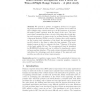Free Online Productivity Tools
i2Speak
i2Symbol
i2OCR
iTex2Img
iWeb2Print
iWeb2Shot
i2Type
iPdf2Split
iPdf2Merge
i2Bopomofo
i2Arabic
i2Style
i2Image
i2PDF
iLatex2Rtf
Sci2ools
MIRAGE
2007
Springer
2007
Springer
Hand Gesture Recognition with a Novel IR Time-of-Flight Range Camera-A Pilot Study
Abstract We present a gesture recognition system for recognizing hand movements in near realtime. The system uses a infra-red time-of-flight range camera with up to 30 Hz framerate to measure 3d-surface points captured from the hand of the user. The measured data is transformed into a cloud of 3d-points after depth keying and suppression of camera noise by median filtering. Principle component analysis (PCA) is used to obtain a first crude estimate on the location and orientation of the hand. An articulated hand model is fitted to the data to refine the first estimate. The unoptimized system is able to estimate the first 7 Degrees of Freedom of the hand within 200 ms. The reconstructed hand is visualized in AVANGO/Performer and can be utilized to implement a natural man-machine interface. The work reviews relevant publications, underlines the advantages and shortcomings of the approach and provides an outlook on future improvements.
| Added | 08 Jun 2010 |
| Updated | 08 Jun 2010 |
| Type | Conference |
| Year | 2007 |
| Where | MIRAGE |
| Authors | Pia Breuer, Christian Eckes, Stefan Müller 0002 |
Comments (0)

